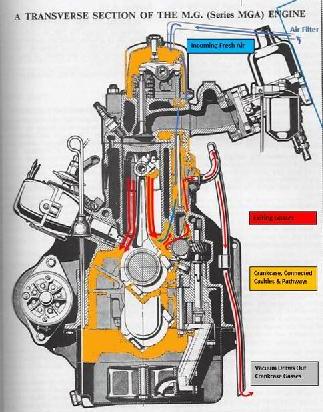The MGA With An Attitude
CRANKCASE VENTILATION TECH - CV-101
The way it works on the early B-Series engines.
On 5/9/02, Evangelos G. Makris wrote:
>"Consider this early B-series engine breathing system: non-vented oil cap, a hose linking the rocker cover to the air filter and a metal tube from the rear chest cover pointing downwards."
Same as my MGA
>"Now, consider this simple modification:
a. throw away the old air filter and put a pancake-type in its place
b. use a long rubber hose from the rocker cover downwards, alongside the chest cover metal tube"
I wouldn't recommend that (with heavy emphasis).
>Will performance improve at all?"
No, unless the piston rings are in such bad shape as to be allowing lots of combustion bypass to blow oil out of the crankcase into the air filter, in which case it needs an overhaul anyway.
>Breathing?"
No improvement, except to the extent that it may avoid clogging the air filter on a badly worn engine.
>Emissions measured at the exhaust tailpipe?"
For an engine in good condition, no. For an engine in sad condition, maybe But any improvement in the bad engine will still leave it in far worse state than optimum. Engines with this type of vent system are pre 1968 design and were not subject to any mandated emissions standards (in the USA).
The first emissions standards here were applied to the 1968 models, which usually resulted in the addition of an air pump and a sealed crankcase. After that the crankcase vent outlet was connected to the intake manifold to intentionally route the crankcase emissions through the engine to be burned with the normal combustion.
>"I've seen it done and the owner told me his car pulled a little bit better and gave lower emissions readings."
That engine is likely in bad condition, and either improvement is probably minimal. Higher emissions at the tailpipe would be caused by crankcase emissions getting into the carburetor intake, which is not supposed to be happening with an engine in good condition. An engine overhaul would likely improve both power and emissions readings considerably more. But if you're on a shoe string budget and not going to pay for the engine repair, then maybe keeping the oil out of the air cleaner would be of some benefit to performance and/or emissions (but still not good for the engine).
>"I'm not sure if the oil cap should remain a non-vented item or be replaced with a vented type though..."
In the case of a badly worn engine, a vented oil cap would vent outwards and dump oil on top of the valve cover. For an engine in good condition a vented cap would allow unfiltered air into the crankcase.


To get a handle on your choice, you should understand how the original (pre-1965) vent system is supposed to work. The hose connection on the air cleaner is inside of the filter element. The metal tube extending downward from the tappet cover terminates at the bottom of the chassis and has a angled cut at the bottom end of the pipe. This is properly called a "draft tube". When exposed to the air moving underneath the car there is a slight vacuum created in the draft tube which draws air through the crankcase to ventilate it. The incoming air is filtered at the air cleaner, and nothing should ever pass back in the other direction from the crankcase to the air cleaner.
This "forced" venting of the crankcase removes combustion bypass vapors to reduce contamination of the engine oil and build up of sludge in the oil and oil pan and to reduce solid deposits on the parts inside of the engine, all of which reduces engine wear. This service includes helping to keep the valve gear on top of the cylinder head clean. If you were to re-route the valve cover vent hose to a point near the bottom termination of the draft tube you would defeat/disable most of the intended forced ventilation of the crankcase. To the extent that some ventilating flow might still occur, the unfiltered air entering the crankcase would be introducing contaminants, like lots of dirt being thrown up by the tires.
For a more detailed explanation of original crankcase ventilation and the possible switch to vacuum driven Positive Crankcase Ventilation, turn the page and read on.
|